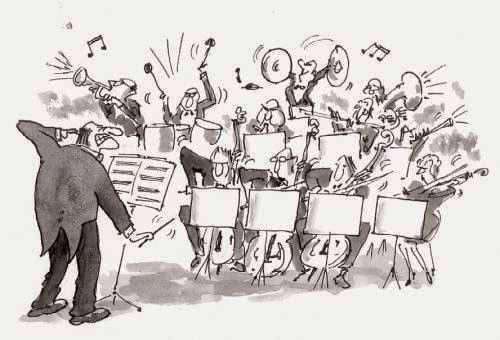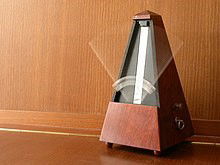Meeting the Challenges of Playing in a Concert Band

Playing in a concert band is a rewarding experience that brings musicians together to create beautiful music. However, like any collaborative effort, it comes with its set of challenges. In this article, we will explore the common challenges faced by musicians in concert bands and provide strategies to overcome them.

Challenge 1: Coordination
One of the primary challenges in concert band playing is coordination among the musicians. Each of the various instruments in a Concert Band has its unique part to play. Achieving harmony and precision requires meticulous coordination.
The first thing musicians must coordinate is their instruments. Are they in good working order? Properly tuned? Have all of the necessary accoutrements like mutes, extra reeds, spare sticks or mallets?
The musicians must then be attuned to the conductor. Without the head the body would not be able to be coordinated at all, unless the group was a chamber group of five or six musicians. However, for a Concert Band, the conductor is essential. The conductor establishes all of the tempos, relative dynamics and other things for the group. He or she also holds the group together through all of the nuances of the music, providing, of course, that the musicians are actually paying attention to the conductor.
After that, the musicians must be listening and responding to the other players in their part, section, instrument type (brass, woodwind or percussion) and the band as a whole. This is where the section leader’s role becomes very important.
Overcoming Challenge 1: Practice and Communication
The instrumentalists must be familiar with their instruments, how they work, what can go wrong, any accessories that might be needed, etc. They must also know the best way to tune the instrument. Even glockenspiel players need to pay attention to any foreign substances on the bars that might impede the proper tone.
It has been said that musicians in ensembles must have at least three eyes – two for the music, one for the conductor and one for the others around them. This, of course, isn’t meant to be taken literally, but it means that they should be able to use their peripheral vision to its fullest to see all that they need to see. To get the best view of the music and conductor at the same time, the music stand needs to be at just the right height that the conductor appears just at the top of it. It may also need to be tilted just a bit to help with that process.
Practicing regularly as a group is essential. This allows musicians to familiarize themselves with each other's parts and playing styles. Additionally, effective communication among band members is crucial. This includes discussing musical interpretations and listening actively during rehearsals.
Cooperation and harmony are key qualities. As Paul said in scripture, “But now indeed there are many members, yet one body”. So, too, in a concert band, these virtues are put into practice as musicians work together to create beautiful music.

Challenge 2: Timing and Rhythm
Maintaining consistent timing and rhythm is another significant challenge in concert band playing. Even a slight deviation can disrupt the flow of the music.
Even if the musicians are paying the proper amount of attention to the conductor, developing a personal sense of consistent timing for all sorts of tempos is important.
Overcoming Challenge 2: Metronome Practice and Counting
Musicians can use metronomes during personal practice to develop a strong sense of timing. Counting out rhythms and practicing with a steady beat can help improve rhythm precision. One method of practice is for the musician to start counting with the metronome, then stop it and keep counting. After a few imaginary measures, the musician turns it back on to see if the count matches that of the metronome.

Challenge 3: Balance and Dynamics
Achieving a balanced sound in a concert band can be tricky, especially when some instruments naturally project more than others. Balancing dynamics, or the variation in loudness and softness, is essential for a cohesive performance.
Again, even if the musicians are paying the proper amount of attention to the conductor, developing the ability to play different dynamics is important. It’s even more important to be able to play them in tune. In general, wind instruments tend to become louder as the notes get higher, and often they tend to get softer for lower notes. It takes more than a little practice to be able to do the opposite.
Overcoming Challenge 3: Dynamics and Section Awareness
Musicians should pay close attention to dynamic markings in the sheet music and, if permitted, mark the music so that they will be certain how to play them. Dynamics are often relative, depending on the number of players on a part and other factors. Musicians should adjust their playing according to how the conductor directs them to play. Section leaders can help maintain balance by communicating with those under their guidance about any issues.

Challenge 4: Individual Practice
While ensemble playing is crucial, individual practice is often neglected. Musicians must master their own parts before coming together as a band. Thomas Reid is among the first to articulate that a chain is only as strong as its weakest link. And so, a band is only as good as its worst player.
Unfortunately, many band members, whether it be public or private school, homeschool or community band, tend to play only for the personal fun or camaraderie of the band, not necessarily to make good music. This can be a challenge for the director as to whether a player should be encouraged, or even required, to better his or her attitude or to be put out of the band.
Overcoming Challenge 4: Personal Responsibility and Discipline
Musicians should take personal responsibility for their part and practice diligently. Setting aside time for focused individual practice is key to improving one's skills and contributing to the success of the band. One rarely finds time to do the important things. Rather, time must often be carved out of the day, and trivial things, though enjoyable and often good in themselves, must be put aside to make room for truly important things. This is called stewardship, which encourages individuals to use their talents and resources wisely for the greater good.
Players in a concert band must dedicate themselves to regular practice. Practice is what a musician does alone, working out such things as intricate passages and scales, phrasing, attacks and breathing. It’s called “woodshedding” because it feels like punishment, although it’s really self-correction with an eye on the prize of a higher level of proficiency. It’s also recommended that concert band musicians, regardless of their instruments, seek guidance from experienced instructors or other mentors. There’s always something new to learn and there’s always room for improvement. Continual improvement mirrors the commitment to growth in many aspects of life, including music, education and one’s relationship with God.
Personal Story – This musician has been reading, writing and playing music for, well, a long time, yet there is always something new to learn. Within the last year I have learned, among other things, what a Wagner cadence is (…IV – iv – I), how to write tight vocal harmonies better and a better way to adjust the equalization in a recording.
Challenge 5: Differing Style and Interpretation
Just as one’s taste in music is different when listening to music, so can one’s playing style be affected by what the player listens to. Certain ways of attacking and releasing notes differ among different playing methods. Jazz playing can sound quite “sloppy” to a classically trained ear while even those using rock music attack and release methods can sound a bit too “clean” to a blues player.
Classical brass players attack the note by placing the tongue behind the teeth and suddenly release it. Rock brass players do the same. Some jazz and blues players simply start blowing, with no clear start to the note.
Classical brass players release the note by stopping the breath. Rock brass players will end the not by putting the tongue in to the “hole” in the lips. Jazz and blues players have a variety of ways to stop the note, depending on the particular “sound” they are looking for.
The distance that a horn player puts between notes can also vary with playing style. Classical musicians follow the notation marking very closely. Rock and blues musicians tend to follow the “feel” of the song, while jazz players often will engage in very personalized expression of their interpretation of the music.
Overcoming Challenge 5: Achieve Style Consensus
A good concert band conductor or director will often choose a variety of pieces to be played at a given concert. If they are all played in the same style with the same interpretation, the concert may sound stagnant. This would be a good time to incorporate some of the different playing styles from the diverse music genres. And, the musicians who listen to jazz or blues and tend to play that way can share their playing methods with the rest of the band.
It would, of course, be up to the director to decide which techniques the band is able to use, and which should be used. This issue of style may only apply to more seasoned bands, since less experienced bands will probably do well to get the notes, dynamics and phrasing right.

Challenge 6: Performance Anxiety
Finally, many musicians struggle with performance anxiety (aka stage fright). The pressure of playing in front of an audience can affect their confidence and overall performance. It often isn’t a lack of self-confidence, but, rather, a fear of the unknown. “What if they don’t like the way I play? What if I make a huge mistake and ruin it for everyone else?”
Overcoming Challenge 6: Mental Preparation and Support
There have been a number of “home remedies” for overcoming stage fright. One of them is for the person to stare at the back wall. This is impossible for band members because they need to be watching the music, the conductor and fellow musicians. Another is to imagine the audience either in their underwear or naked. This could cause bouts of unwanted and uncontrollable, and totally misunderstood, laughter.
More realistically, musicians can alleviate performance anxiety through mental preparation techniques such as deep breathing, visualization and positive self-talk. Deep breathing can help lower blood pressure, manage anxiety and reduce tension, among other things. Visualization and positive self-talk are related. Musicians with stage fright can picture themselves playing their part successfully and well. They can also ignore the issue of whether or not people like what they play; the real reason for their playing is to make great music, regardless of whether people like it or not.
Additionally, the support and encouragement of fellow band members can provide reassurance and confidence.
Finally, another way that the conductor can help the whole band become more confident about their playing is to play some samples of professional musicians who have flubbed up and continued playing well, with no regard for the audiences response. (The main reason most audiences don’t respond negatively to such an occurrence is that if the player acts as if that was the intended rendering of that note or phrase, the audience doesn’t notice.) There are a number of such videos on YouTube. The conductor will need to search for the best videos for the band.
The worst thing for players to do if they do make a mistake is to make a face or otherwise indicate that a mistake has been made.
It has been said that there are no atheists in foxholes (that is, the heat of battle). So, too, overcoming performance anxiety can be seen as an opportunity to trust in God, and to find strength in His presence during challenging moments.
Conclusion
Playing in a concert band offers tremendous joy and fulfillment, but it comes with its share of challenges. By practicing together, communicating effectively, and addressing individual and group issues, musicians can overcome these obstacles and create harmonious, beautiful music. These challenges can also be seen as opportunities for growth, unity, and reflection on important values such as cooperation, discipline, and reliance on God.
Salt Cellar Creations understands the challenges that playing in a concert band can present. SCC has a growing library of original works and arrangements aimed at making a concert band sound great without requiring professional grade players. Explore the offerings HERE.
SCC can also compose an original piece for you or do a custom arrangement for you. There are two ways that this can be done; one is much more affordable than the other. And SCC is always looking for ideas of pieces to arrange or suggestions for original pieces. Please CONTACT ME to let me know what you think.
We have sold music not only in the US but in Canada, the United Kingdom, France, Australia, New Zealand, Austria and Germany. Please visit the WEBSITE or CONTACT US to let us know what we can do for you!